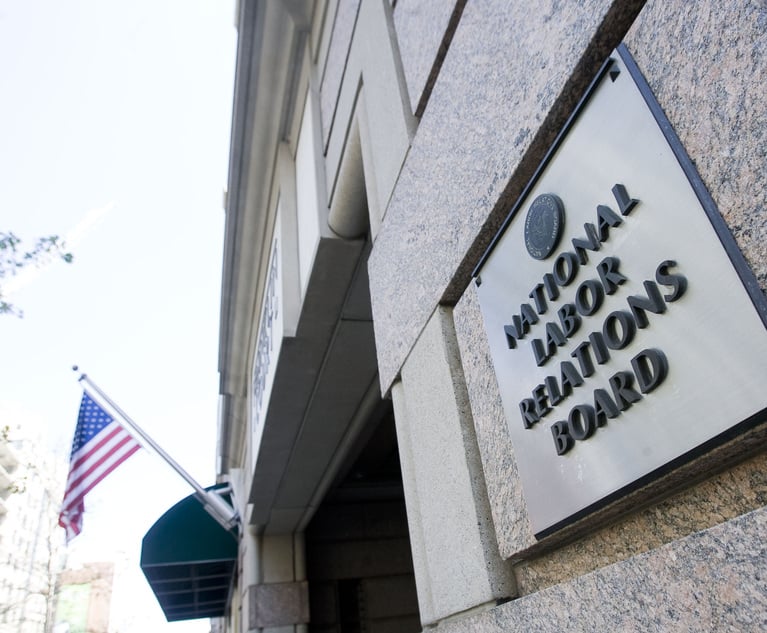 Credit: mojo cp/Shutterstock.com
Credit: mojo cp/Shutterstock.comLegal Departments Are Expanding Use of Alternative Fee Arrangements
"Legal departments are more creative in breaking a matter down to its component parts in order to find ways to get at least a little predictability on what they are going to spend," Kristina Satkunas, director of strategic consulting at LexisNexis CounselLink in Richmond, Virginia, said.
July 14, 2020 at 09:51 AM
3 minute read
In-house counsel are increasingly using alternative fee arrangements for high-volume and predictable matters such as labor and employment and finance, loans and investments, according to LexisNexis CounselLink's 2020 Enterprise Legal Management Trends Report.
According to the report published Tuesday, approximately 32% of finance, loan and investment matters in 2019 included some kind of alternative fee arrangement and approximately 25% of labor and employment matters involved an alternative fee arrangement. In 2018, approximately 28% of finance, loan and investment matters included an alternative fee arrangement and just under 25% of labor and employment matters included an alternative fee arrangement.
"Matters that are relatively similar and high-volume are easier to reach an agreement as to what a fair price might be for that type of work," Kristina Satkunas, director of strategic consulting at LexisNexis CounselLink in Richmond, Virginia, and author of the report, said in an interview.
Labor and employment immigration issues are often subject to an alternative fee arrangement. In the finance, loan and investment space, in-house counsel and law firms often agree to an alternative fee arrangement.
There has also been an increase in alternative fee arrangements for high-cost and less frequent work such as mergers and acquisitions. In 2019, 19% of M&A work included some kind of alternative fee arrangement. In previous trend reports, the number was just over 10% for M&A work. Satkunas said she has heard about creating pricing around early due diligence and drafting particular agreements.
"I think that is a positive thing to see. Legal departments are more creative in breaking a matter down to its component parts in order to find ways to get at least a little predictability on what they are going to spend," Satkunas said.
She said she would expect to see alternative fee arrangements used in more complex matters in the future.
Just over 12.1% of all matters in 2019 included an alternative fee arrangement. In 2018, 12.2% of all matters included an alternative fee arrangement. Satkunas said that number has risen from 2017, where only 9.2% of all matters included an alternative fee arrangement. The report does not have data on what kinds of alternative fee arrangements were utilized most often. Satkunas said the flat fee is most commonly used. However, for more complex matters legal departments are getting creative.
"There may be a flat fee up to a certain point. Anything that gets billed after that threshold is billed at an hourly rate, but there is a discount at that hourly rate and increases as the total spend on that matter goes up," Satkunas said.
Those kinds of arrangements are made to incentivize the matter as quickly as possible because the law firm is getting paid at a greater discount as legal spend for a matter increases. It is likely that legal departments will continue to utilize alternative fee arrangements in the future given the current COVID-19 crisis and the looming threat of another recession.
"I think that pressure to manage costs and know what they [in-house counsel] can anticipate is something that will get pushed back to the law firms," Satkunas said.
This content has been archived. It is available through our partners, LexisNexis® and Bloomberg Law.
To view this content, please continue to their sites.
Not a Lexis Subscriber?
Subscribe Now
Not a Bloomberg Law Subscriber?
Subscribe Now
NOT FOR REPRINT
© 2025 ALM Global, LLC, All Rights Reserved. Request academic re-use from www.copyright.com. All other uses, submit a request to [email protected]. For more information visit Asset & Logo Licensing.
You Might Like
View All
Preparing for 2025: Anticipated Policy Changes Affecting U.S. Businesses Under the Trump Administration

Employers Race to File NLRB Petitions to Gain Upper Hand in Union Organizing
5 minute read
Tractor Supply Co.'s Stock Takes Hit After Activists Bash Its Embrace of DEI
6 minute readTrending Stories
- 1Deal Watch: Latham, Paul Weiss, Debevoise Land on Year-End Big Deals. Plus, Mixed Messages for 2025 M&A
- 2Bathroom Recording Leads to Lawyer's Disbarment: Disciplinary Roundup
- 3Conn. Supreme Court: Workers' Comp Insurance Cancellations Must Be Unambiguous
- 4To Avoid Conflict, NYAG Hands Probe Into Inmate's Beating Death to Syracuse-Area DA
- 5Scripture-Quoting Employee Sues Company for Supporting LGBTQ Pride
Who Got The Work
Michael G. Bongiorno, Andrew Scott Dulberg and Elizabeth E. Driscoll from Wilmer Cutler Pickering Hale and Dorr have stepped in to represent Symbotic Inc., an A.I.-enabled technology platform that focuses on increasing supply chain efficiency, and other defendants in a pending shareholder derivative lawsuit. The case, filed Oct. 2 in Massachusetts District Court by the Brown Law Firm on behalf of Stephen Austen, accuses certain officers and directors of misleading investors in regard to Symbotic's potential for margin growth by failing to disclose that the company was not equipped to timely deploy its systems or manage expenses through project delays. The case, assigned to U.S. District Judge Nathaniel M. Gorton, is 1:24-cv-12522, Austen v. Cohen et al.
Who Got The Work
Edmund Polubinski and Marie Killmond of Davis Polk & Wardwell have entered appearances for data platform software development company MongoDB and other defendants in a pending shareholder derivative lawsuit. The action, filed Oct. 7 in New York Southern District Court by the Brown Law Firm, accuses the company's directors and/or officers of falsely expressing confidence in the company’s restructuring of its sales incentive plan and downplaying the severity of decreases in its upfront commitments. The case is 1:24-cv-07594, Roy v. Ittycheria et al.
Who Got The Work
Amy O. Bruchs and Kurt F. Ellison of Michael Best & Friedrich have entered appearances for Epic Systems Corp. in a pending employment discrimination lawsuit. The suit was filed Sept. 7 in Wisconsin Western District Court by Levine Eisberner LLC and Siri & Glimstad on behalf of a project manager who claims that he was wrongfully terminated after applying for a religious exemption to the defendant's COVID-19 vaccine mandate. The case, assigned to U.S. Magistrate Judge Anita Marie Boor, is 3:24-cv-00630, Secker, Nathan v. Epic Systems Corporation.
Who Got The Work
David X. Sullivan, Thomas J. Finn and Gregory A. Hall from McCarter & English have entered appearances for Sunrun Installation Services in a pending civil rights lawsuit. The complaint was filed Sept. 4 in Connecticut District Court by attorney Robert M. Berke on behalf of former employee George Edward Steins, who was arrested and charged with employing an unregistered home improvement salesperson. The complaint alleges that had Sunrun informed the Connecticut Department of Consumer Protection that the plaintiff's employment had ended in 2017 and that he no longer held Sunrun's home improvement contractor license, he would not have been hit with charges, which were dismissed in May 2024. The case, assigned to U.S. District Judge Jeffrey A. Meyer, is 3:24-cv-01423, Steins v. Sunrun, Inc. et al.
Who Got The Work
Greenberg Traurig shareholder Joshua L. Raskin has entered an appearance for boohoo.com UK Ltd. in a pending patent infringement lawsuit. The suit, filed Sept. 3 in Texas Eastern District Court by Rozier Hardt McDonough on behalf of Alto Dynamics, asserts five patents related to an online shopping platform. The case, assigned to U.S. District Judge Rodney Gilstrap, is 2:24-cv-00719, Alto Dynamics, LLC v. boohoo.com UK Limited.
Featured Firms
Law Offices of Gary Martin Hays & Associates, P.C.
(470) 294-1674
Law Offices of Mark E. Salomone
(857) 444-6468
Smith & Hassler
(713) 739-1250







